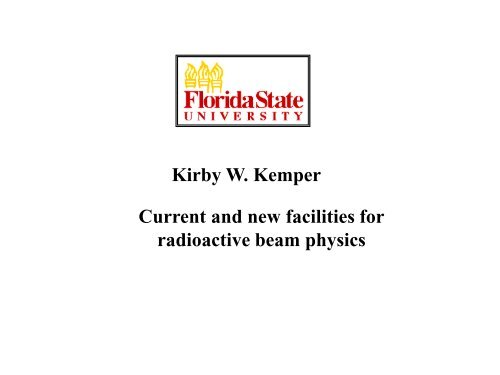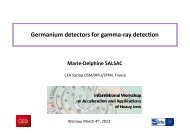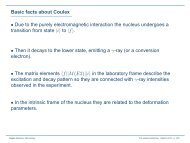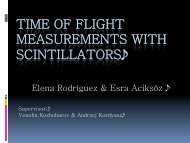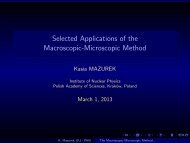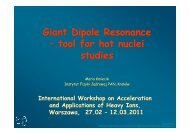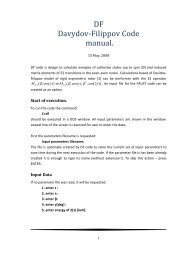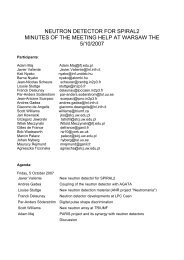A world tour of Radioactive Beam Laboratories
A world tour of Radioactive Beam Laboratories
A world tour of Radioactive Beam Laboratories
You also want an ePaper? Increase the reach of your titles
YUMPU automatically turns print PDFs into web optimized ePapers that Google loves.
Kirby W. KemperCurrent and new facilities forradioactive beam physics
Map <strong>of</strong> Florida
Florida State University in 1851-First as a seminaryfor men then in 1904 as a women’s college and then in 1947became a co-ed university.Today has 39,000 students.
Westcott Building, Florida State University, Tallahassee.
How do we know we have seen new physics withradioactive beams?While I will discuss proposed new facilities hereplease keep in mind that we must havehigh quality stablebeam data for comparison.
RIB* FacilitiesPresent and FutureRobert TribbleTexas A&M UniversityTexas, USA*Rare Isotope <strong>Beam</strong>; <strong>Radioactive</strong> Ion <strong>Beam</strong>
Basic Techniques for Producing RIBsPrimraySourceISOLIn FlightIn Flight + StoppingProductionTargetIon SourceElectromagneticSeparatorIon TrapmmGas StoppingPostAcceleratorIon TrapSecondaryExperimentFragmentation,Reactions
ISOL PropertiesIn ISOL you have a driver beam, <strong>of</strong>ten protons that strikes a target say <strong>of</strong>uranium carbide heated to very high temperatures and then the radio active productis released and accelerated to energy <strong>of</strong> experiment.Advantage- can get beams <strong>of</strong> low energy that are intense.Disadvantages- target chemistry and beam production very difficulteach beam must be separately developednot possible to study short lived isotopessources are very radioactive so really need severalsource boxes (typical cost $1.5M)In flight beam productionFragment incoming beam on a Be target to produce product <strong>of</strong> interestfor example use a 48 Ca primary beam to produce 44 SAdvantages- Study very short lived nuclei, can use very thick targetsDisadvantages-beams are moving at 0.5c so gamma rays have huge Dopplercorrections, and theory <strong>of</strong> transfer reactions not well developedAt present the fragmentation technique is the only one that allows studies closeto the neutron dripline for above mass 10
Inflight + StoppingUse fragmentation to produce beam, stop beam in gas, extract products <strong>of</strong>interest, reacclerate and then use at energy you wantFor example, with fast beams only Coulomb excite first 2+ but withlow energy beams could observe first 3- etcTheory <strong>of</strong> transfer reactions for low energies( ~10 MeV/amu)is well developed so can extract information on location <strong>of</strong>single particle levels to search for predicted decrease <strong>of</strong> spin-orbitstrength at neutron driplineYou can trap very exotic nuclei and search for exotic effects like anapole moments
Present Facilities*andthe Science <strong>of</strong> RIBsScience topics:• masses, structure, reactions, astrophysics, . . .• Enormous growth over past decade!• See talks at ENAM08!!Buckle up for a whirlwind <strong>tour</strong>!!*Limited to facilities with multi-MeV beams
RIB Facilities(Operating or Under Construction)
European Facilities
GSI todayFuture facilitySIS 100/300UNILACSIS 18ESRSuperFRSCBMRare-IsotopeProduction TargetPrimary <strong>Beam</strong>s• 40 Ar 18+ 2x10 12 /s @ 1 –• 238 U 28+: 5x10 11 /s @ 1 –2 AGeV2 AGeV• 40 Ar 18+ 2x10 10 /s @ 1 – 45 AGeV• 238 U 92+: 1x10 10 /s @ 1 – 35 AGeV100 x 1000 times present intensity• Protons: 2 – 5x10 13 /s @ 30 GeVSecondary <strong>Beam</strong>s100 mHESR• Broad range <strong>of</strong> radioactive beamsup to 1 – 2 AGeV• RI- Intensities up to 10 000 over present• AntiprotonsRESRCRPP /APNESRAntiprotonProduction TargetStorage and Cooling <strong>of</strong> <strong>Beam</strong>s•FLAIR<strong>Radioactive</strong> beams• e - – A (or antiproton – A ) collider• Antiprotons: > 10 11 at 0.8 – 15 GeV/c• Future: Polarized antiprotons
Comparison <strong>of</strong> FRS with Super-FRSApertures(Super-FRS) ≈ 2 X Apertures(FRS)εRxΔppBρion= 20 πmm mr= ± 1 %max= 18 Tm= 1500Separation with two degrader stagesRHans Geissel, Super-FRS Evaluation 08εφφxxyΔppBρion=maxε= ±= ±= ±y===40 πmm mr40 mr,20 mr2.5 %20 Tm1500
SPIRAL 2@GANIL - A <strong>world</strong> leading ISOL FacilityGANIL facilityLIRATCIME CyclotronAcceleration <strong>of</strong> RI <strong>Beam</strong>sE < 25 MeV/A, 6-8 MeV/A FF1+Production buildingC converter + UCx target≤ 10 14 fissions/sRFQHeavy-Ion ECRsource (A/q=3), 1mAA/q=6 LaterStable Heavy-IonExp. HallSuper conducting LINAC40MeV d, 5 mA , 14 MeV/A HI
ISOLDE HallPlanning 10 MeV/A beams
( 6 He, 8 He)
Neutron Facility: BNCT – LENOSThermal neutrons 10 9 n cm -2 s -1Fast neutrons 10 14 n s -1TRASCO RFQ: protons 5MeV 25mADirect Target 10 13 f s -1 and Mass Separator(on HV platform 250KV)Cyclotron: protons70 MeV 0.75mACharge Breeder (200KW) installed over HVplatform (250KV)Cryopanelradioactive gasescatcherIsotope selector 1/20000SC RFQ PIAVEGeneral SPES layoutSC Linac ALPILEGNARO
China, India and Japan
Fast RI beams- RIPSv~0.3cRIKEN RI-<strong>Beam</strong> Factory (RIBF)SHE (e.g. Z=113)~5 MeV/nucleonRILACAVFfRCRRCSRCpol. d beamsIRCv~0.6c135 MeV/nucleonfor light nuclei (1986-)RI beams (
RIB Facilities at IMP - Lanzhou (China)• RIBLL 1RIBs produced via PF& transfer with primarybeams up to Kr• RIBLL 2RIBs produced via PF& TF with primary beamsup to U (Xe up to now)• ETFExternal Target Facilityfor RIB experiment &asymmetry nuclearmatter research• CSReMass measurementwith cooling storage ringSSCRIBLL1HIRFL - CSRSFCCSRm12C, 36 Ar, 129 Xe4x10 8 for Ar-368MeV/uSFC:(A/q=2)SSC:≤ 10 AMeV≤ 100 AMeV(A/q=2)CSRm: ≤1.0 AGeV (A/q=2)CSRe: ≤ 0.76 AGeV (A/q=2)ETF8x10 9 for C-660MeV/uCSReRIBLL2CSReRIB from RIBLL2 (test)isochronous mode in CSR∆M/M~10 -5Hushan Xu
XI th plan: Acceleration up to 1.3 MeV/u &Electron Linac as new primary accelerator(funding obtained in December 2007)VEC K130Cyclotrone-Linac50 MeV, 100 kWnewThick-targetCharge BreederSeparator1.5 keV/uRFQ98 keV/u415 keV/uLINAC1,2,3LINACs 4-8new1.3 MeV/u RIB
North American Facilities
TRIUMFCanada's National Laboratory for Particle andNuclear PhysicsISAC-IIISACMesonHall500MeVCyclotron
National Superconducting Cyclotron LaboratoryCoupled Cyclotron FacilityPrimary beams (He–U): E/A ≤ 200 MeVFast and stopped rare isotopes beamsReaccelerated beams in 2010Research themes:Properties <strong>of</strong> nuclei very far fromstabilityNuclear processes responsible for thechemical evolution <strong>of</strong> the universeEquation <strong>of</strong> state (EOS) <strong>of</strong> neutron-richnuclear matter<strong>Beam</strong> dynamics and acceleratorphysics: superconducting cyclotrons,linacs, and magnetsMain funding comes fromthe U.S. National ScienceFoundation (NSF) andMichigan State Universitywww.nscl.msu.edu
Holifield Rare Isotope <strong>Beam</strong> Facility25MV TandemElectrostaticAcceleratorStable IonInjector (ISIS)Injector for <strong>Radioactive</strong>Ion Species 1 (IRIS1)Oak Ridge IsochronousCyclotron (ORIC)Daresbury RecoilSeparator (DRS)EngeSpectrographHigh Power TargetLaboratory (HPTL)On-Line TestFacility (OLTF)Recoil MassSpectrometer(RMS)
CARIBU & Energy Upgrade• CARIBU gives access to exotic beams• Energy Upgrade provides beams from CARIBU in theenergy regime <strong>of</strong> 12 MeV/u252Cf caskIsobar separatorCARIBUATLASEnergyUpgrade
TwinSol at the Univ. <strong>of</strong> Notre Dame• Two 6T superconducting solenoids act as thick lenses to focus an intense beam <strong>of</strong> shortlivedradioactive ions onto a secondary target (in-flight production).• Primary beams from a 10.5 MV FN-tandem accelerator.• One <strong>of</strong> the first instruments to produce beams <strong>of</strong> radioactive ions at energies near theCoulomb barrier.
RESOLUT: a newradioactive beam facility at FSUSolenoid 2Magnetic SpectrographSolenoid 1Target PositionExperimentMass Magnetic selectionSpectrograph slitsRF-ResonatorRF-ResonatorProductiontarget• In-flight production <strong>of</strong> radioactive beams ininverse kinematics• Combination <strong>of</strong> Superconducting RF-Resonatorwith high acceptance magnetic Spectrograph tocreate mass spectrometer for E~5 MeV/usecondary beams
South America
São Paulo Pelletron Laboratory8 MV tandem3-5 MeV.ARIBRASRIBRAS = <strong>Radioactive</strong> Ion <strong>Beam</strong>s Brasil
The Future• Continuing upgrades at existing facilities• Completion <strong>of</strong> GSI/FAIR• Development <strong>of</strong> high power at RIKEN• New facilities
The European ISOL Road Map• Vigorous exploitation <strong>of</strong> current ISOLfacilities : EXCYT, REX/ISOLDE, SPIRAL• Construction <strong>of</strong> intermediate generationfacilities: SPIRAL2, HIE-ISOLDE, SPES• Design and prototyping in the framework <strong>of</strong>EURISOL Design-Study (20 Labs, 14 Countries,30M€)
H+, D+,3He++IonsourcesH-100keVRFQ176MHzSecondaryfragmentationtarget1.5 MeV/uSpokeISCL264 MHzβ = 0.385HWRs176MHzβ = 0.09, β = 0.15Elliptical ISCL704 MHzβ = 0.3 β = 0.47 β = 0.65β = 0.7860 MeV/q 140 MeV/q8 HWRsISCL176 MHzβ = 0.273-spoke ISCL325 MHzA possible schematiclayoutfor a EURISOL facility3 QWRsISCL88 MHzβ = 0.14Elliptical ISCL704 MHz>200 MeV/qD+, A/q=2QWRISCL88MHzβ = 0.065One <strong>of</strong>several100-kW directtargetstationsBunchingRFQsRFQ1GeV/qH-, H+,3 He++n-generatorLowresolutionmass-selectorChargeselectorChargebreederUC xtarget4-MWtargetstation1+ ionsourceHigh-resolutionmass-selector20-150 MeV/u(for 132 Sn)9.3- 62.5 MeV/u 2.1-19.9 MeV/uTo high-energyexperimental areasTo medium-energy experimental areasTo low-energy areas
U.S. – FRIBRecommendation 2:We recommend construction <strong>of</strong> theFacility for Rare Isotope <strong>Beam</strong>s, FRIB,a <strong>world</strong>-leading facility for the study <strong>of</strong>nuclear structure, reactions and astrophysics.Experiments with the newisotopes produced at FRIB will lead to acomprehensive description <strong>of</strong> nuclei,elucidate the origin <strong>of</strong> the elements in thecosmos, provide an understanding <strong>of</strong>matter in the crust <strong>of</strong> neutron stars, andestablish the scientific foundation forinnovative applications <strong>of</strong> nuclearscience to society.2007 Long Range PlanSite selection underway soon!
FRIB at NSCL
FRIB at ANL•Driver linac: 200 MeV/u 238 U, 400 kW (5x10 13 uranium ions/s). All requiredaccelerator structures prototyped at ANL;•Rare isotopes for experimental program with stopped, reaccelerated and fastbeams;•Rare isotopes for reacceleration from ANL’s gas stopping technique;•Reacceleration to ~ 15 MeV/u through ATLAS.
FROM ENAM’04 to ENAM’08• GSI/FAIR started• RIKEN operating• SPIRAL 2 started• ISOLDE upgrade• TRIUMF ISACII• RIA ® FRIB• EURISOL R&D• New smaller projects- SPES- <strong>Beam</strong> at EXCYT- CARIBU at ATLAS- TAMU upgrade- High power target at HRIBF- Low energy beams at MSU- Solenoids at Florida State- VEC upgrade- Beijing upgrade- Lanzhou Facility


